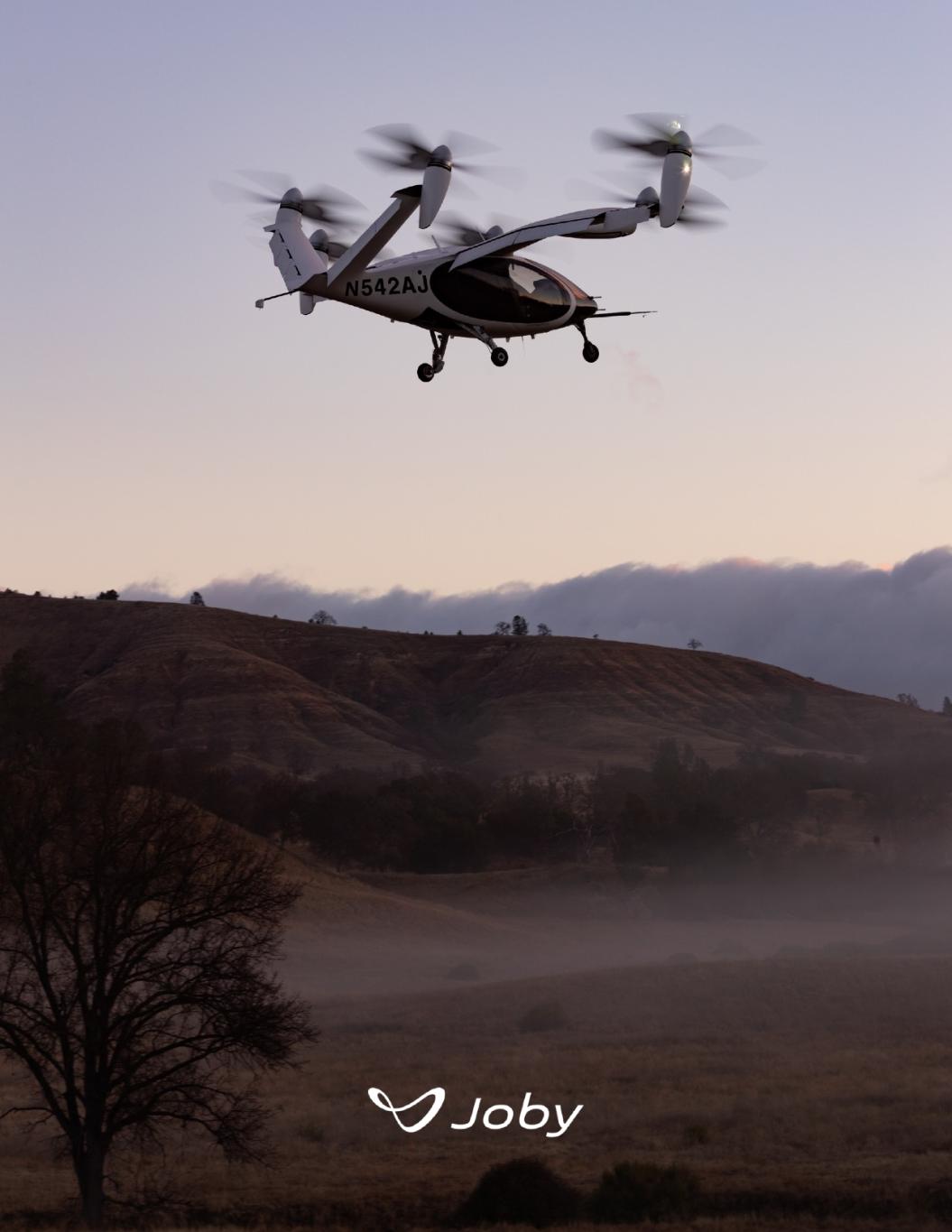
Shareholder Letter Q1 2022
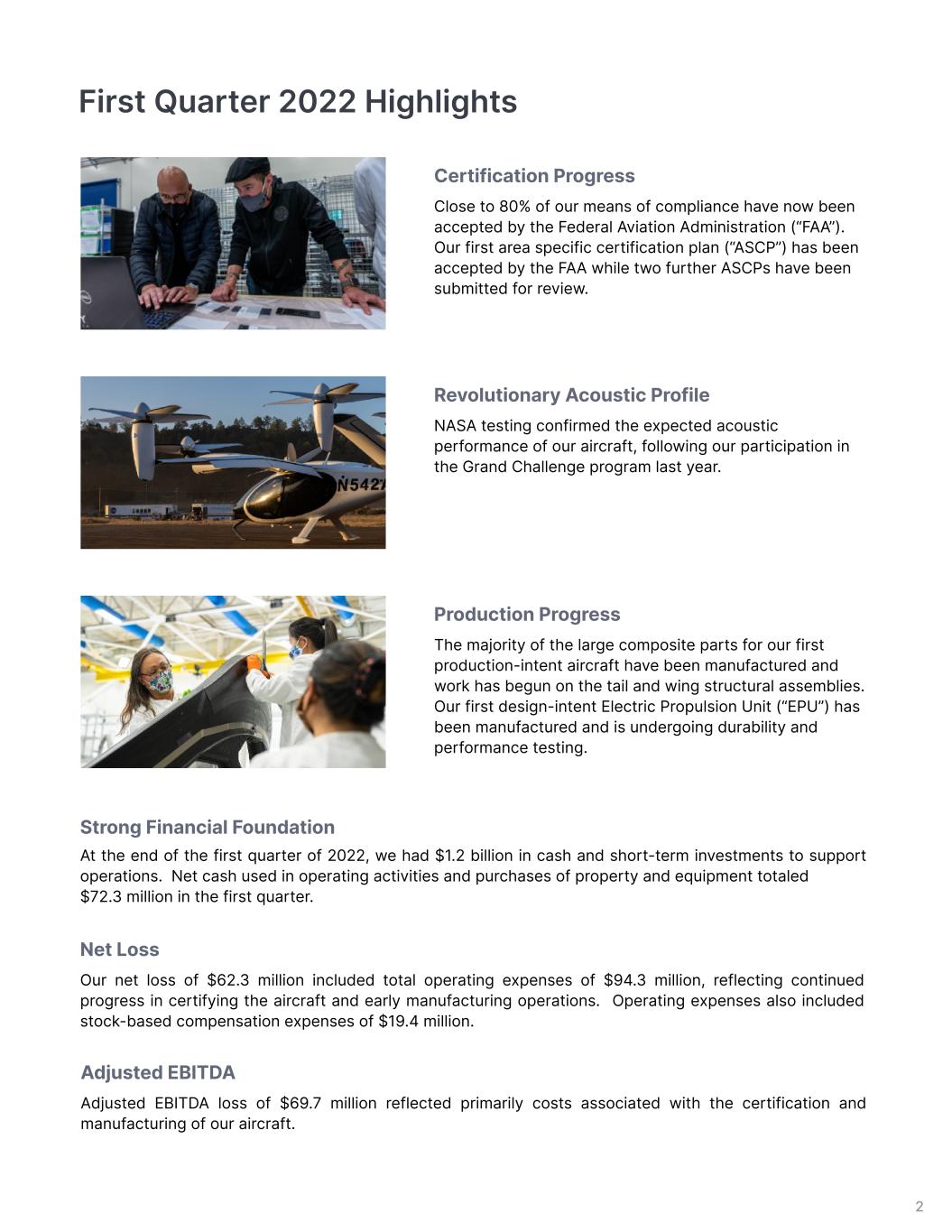
First Quarter 2022 Highlights Certification Progress Close to 80% of our means of compliance have now been accepted by the Federal Aviation Administration (“FAA”). Our first area specific certification plan (“ASCP”) has been accepted by the FAA while two further ASCPs have been submitted for review. Production Progress The majority of the large composite parts for our first production-intent aircraft have been manufactured and work has begun on the tail and wing structural assemblies. Our first design-intent Electric Propulsion Unit (“EPU”) has been manufactured and is undergoing durability and performance testing. Net Loss Our net loss of $62.3 million included total operating expenses of $94.3 million, reflecting continued progress in certifying the aircraft and early manufacturing operations. Operating expenses also included stock-based compensation expenses of $19.4 million. Revolutionary Acoustic Profile NASA testing confirmed the expected acoustic performance of our aircraft, following our participation in the Grand Challenge program last year. Strong Financial Foundation At the end of the first quarter of 2022, we had $1.2 billion in cash and short-term investments to support operations. Net cash used in operating activities and purchases of property and equipment totaled $72.3 million in the first quarter. Adjusted EBITDA Adjusted EBITDA loss of $69.7 million reflected primarily costs associated with the certification and manufacturing of our aircraft. 2
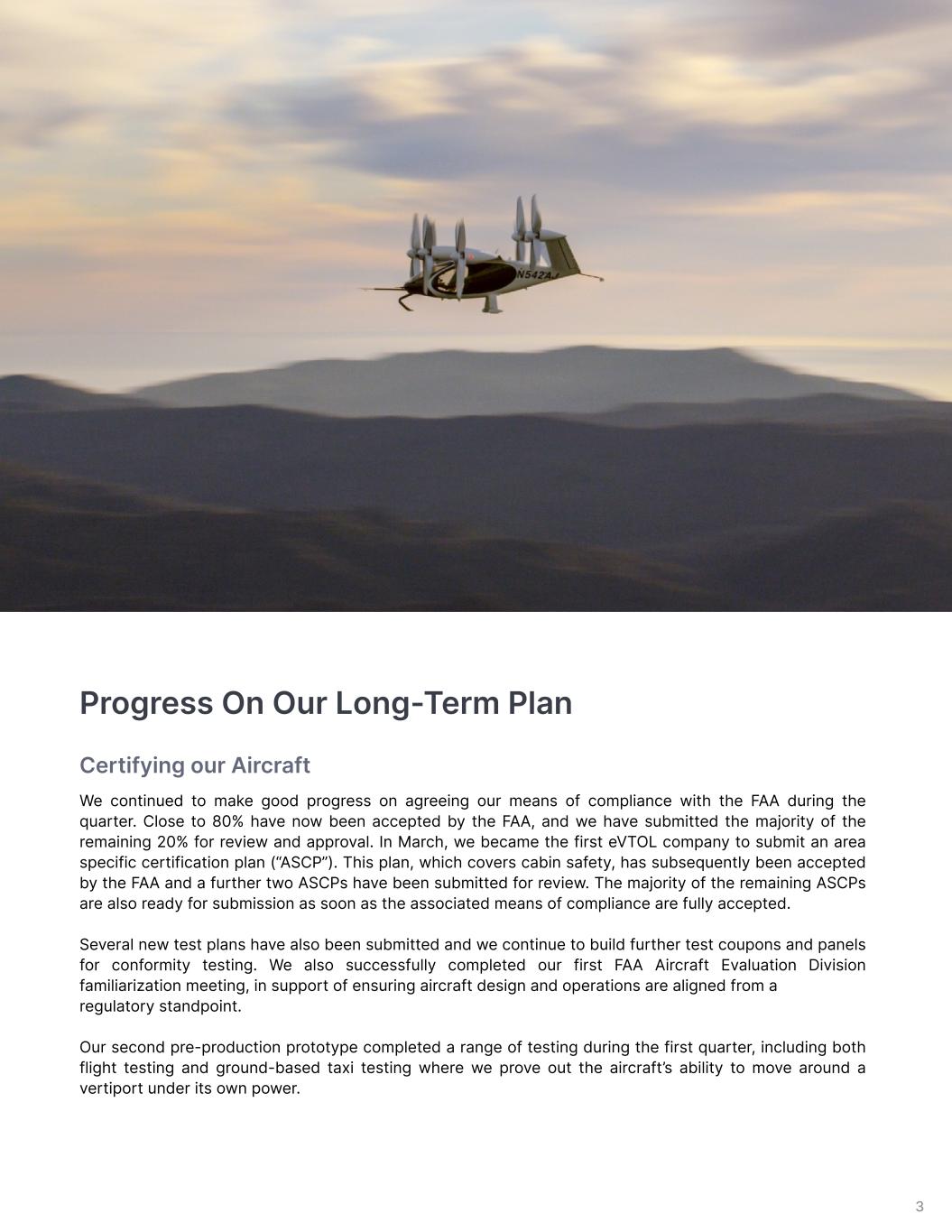
Progress On Our Long-Term Plan Certifying our Aircraft We continued to make good progress on agreeing our means of compliance with the FAA during the quarter. Close to 80% have now been accepted by the FAA, and we have submitted the majority of the remaining 20% for review and approval. In March, we became the first eVTOL company to submit an area specific certification plan (“ASCP”). This plan, which covers cabin safety, has subsequently been accepted by the FAA and a further two ASCPs have been submitted for review. The majority of the remaining ASCPs are also ready for submission as soon as the associated means of compliance are fully accepted. Several new test plans have also been submitted and we continue to build further test coupons and panels for conformity testing. We also successfully completed our first FAA Aircraft Evaluation Division familiarization meeting, in support of ensuring aircraft design and operations are aligned from a regulatory standpoint. Our second pre-production prototype completed a range of testing during the first quarter, including both flight testing and ground-based taxi testing where we prove out the aircraft’s ability to move around a vertiport under its own power. 3
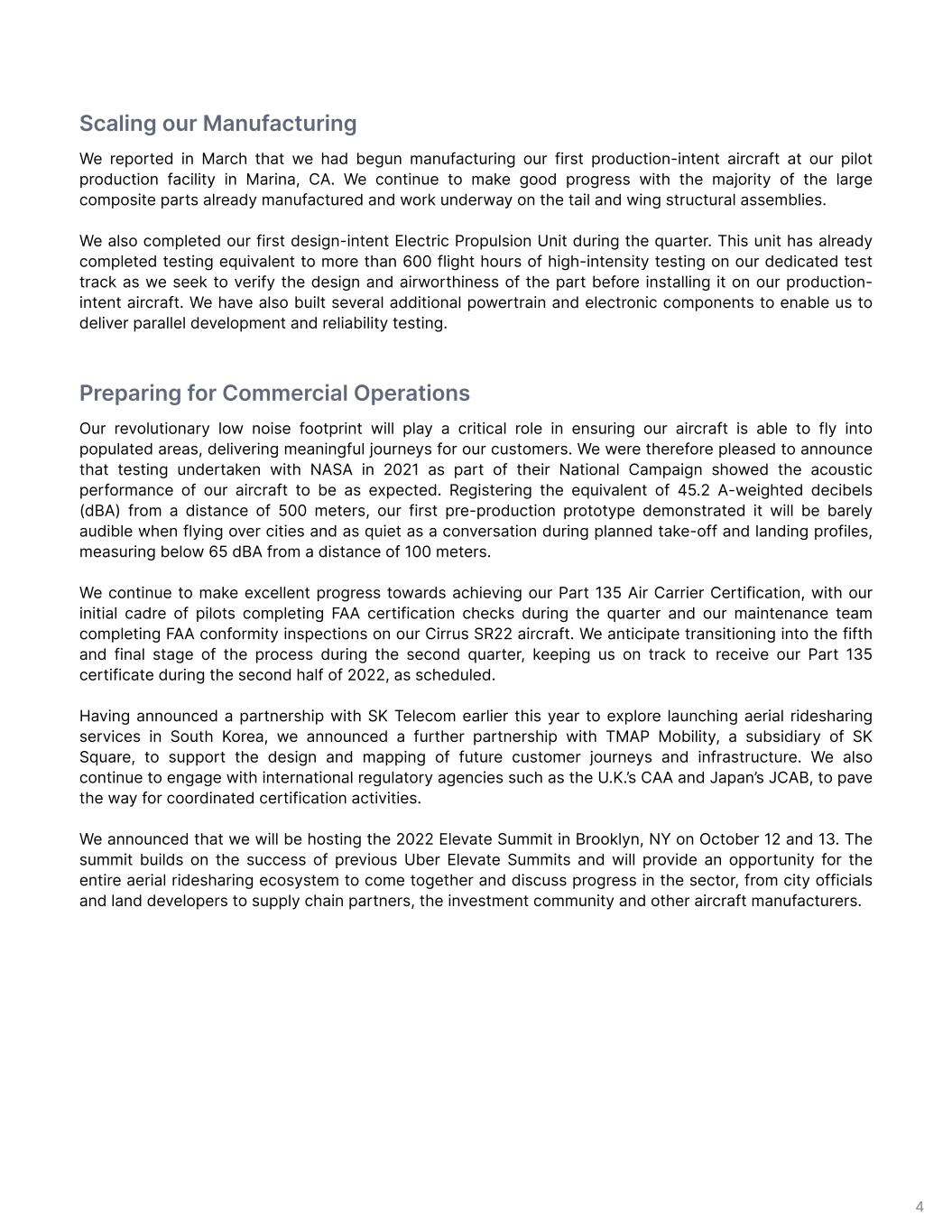
Scaling our Manufacturing We reported in March that we had begun manufacturing our first production-intent aircraft at our pilot production facility in Marina, CA. We continue to make good progress with the majority of the large composite parts already manufactured and work underway on the tail and wing structural assemblies. We also completed our first design-intent Electric Propulsion Unit during the quarter. This unit has already completed testing equivalent to more than 600 flight hours of high-intensity testing on our dedicated test track as we seek to verify the design and airworthiness of the part before installing it on our production- intent aircraft. We have also built several additional powertrain and electronic components to enable us to deliver parallel development and reliability testing. Preparing for Commercial Operations Our revolutionary low noise footprint will play a critical role in ensuring our aircraft is able to fly into populated areas, delivering meaningful journeys for our customers. We were therefore pleased to announce that testing undertaken with NASA in 2021 as part of their National Campaign showed the acoustic performance of our aircraft to be as expected. Registering the equivalent of 45.2 A-weighted decibels (dBA) from a distance of 500 meters, our first pre-production prototype demonstrated it will be barely audible when flying over cities and as quiet as a conversation during planned take-off and landing profiles, measuring below 65 dBA from a distance of 100 meters. We continue to make excellent progress towards achieving our Part 135 Air Carrier Certification, with our initial cadre of pilots completing FAA certification checks during the quarter and our maintenance team completing FAA conformity inspections on our Cirrus SR22 aircraft. We anticipate transitioning into the fifth and final stage of the process during the second quarter, keeping us on track to receive our Part 135 certificate during the second half of 2022, as scheduled. Having announced a partnership with SK Telecom earlier this year to explore launching aerial ridesharing services in South Korea, we announced a further partnership with TMAP Mobility, a subsidiary of SK Square, to support the design and mapping of future customer journeys and infrastructure. We also continue to engage with international regulatory agencies such as the U.K.’s CAA and Japan’s JCAB, to pave the way for coordinated certification activities. We announced that we will be hosting the 2022 Elevate Summit in Brooklyn, NY on October 12 and 13. The summit builds on the success of previous Uber Elevate Summits and will provide an opportunity for the entire aerial ridesharing ecosystem to come together and discuss progress in the sector, from city officials and land developers to supply chain partners, the investment community and other aircraft manufacturers. 4
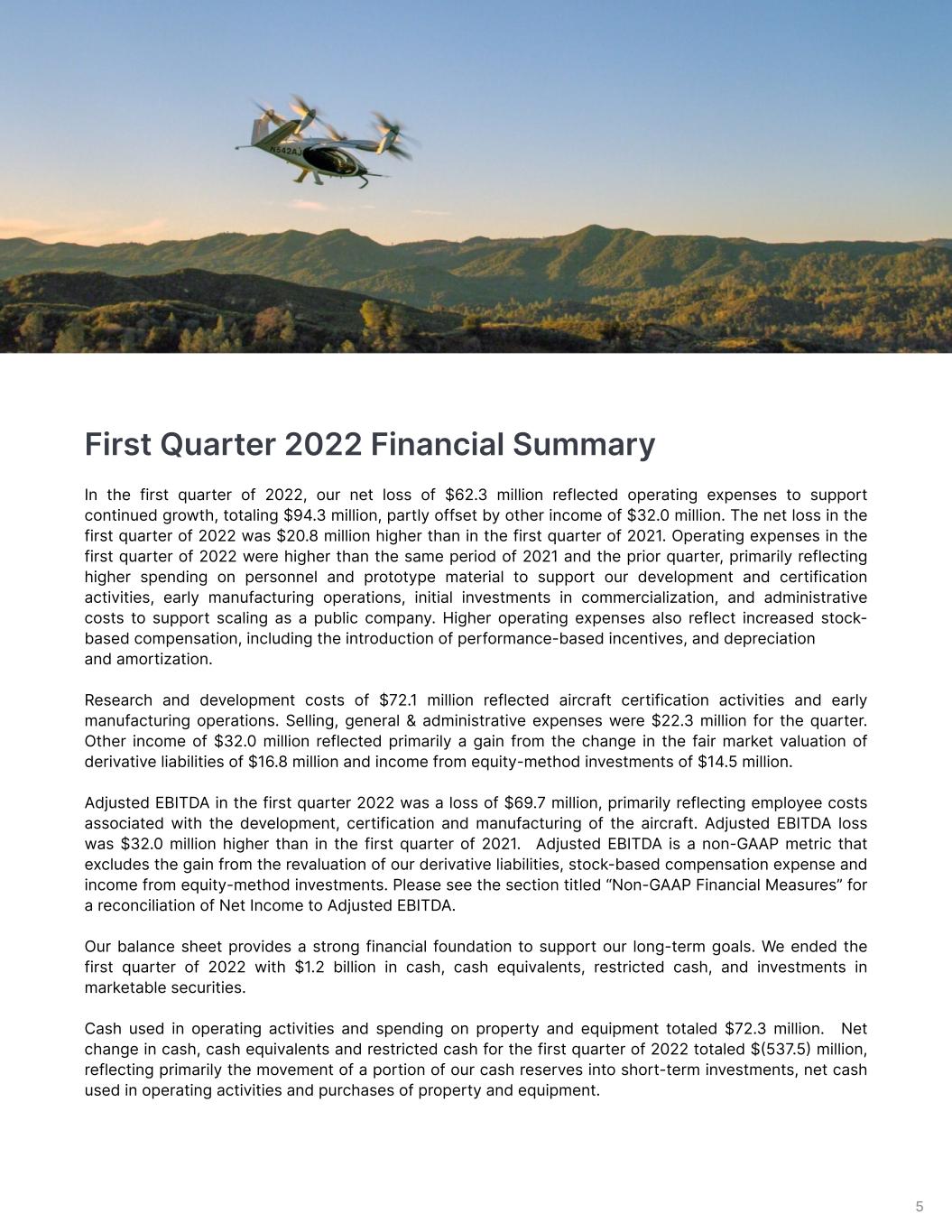
First Quarter 2022 Financial Summary In the first quarter of 2022, our net loss of $62.3 million reflected operating expenses to support continued growth, totaling $94.3 million, partly offset by other income of $32.0 million. The net loss in the first quarter of 2022 was $20.8 million higher than in the first quarter of 2021. Operating expenses in the first quarter of 2022 were higher than the same period of 2021 and the prior quarter, primarily reflecting higher spending on personnel and prototype material to support our development and certification activities, early manufacturing operations, initial investments in commercialization, and administrative costs to support scaling as a public company. Higher operating expenses also reflect increased stock- based compensation, including the introduction of performance-based incentives, and depreciation and amortization. Research and development costs of $72.1 million reflected aircraft certification activities and early manufacturing operations. Selling, general & administrative expenses were $22.3 million for the quarter. Other income of $32.0 million reflected primarily a gain from the change in the fair market valuation of derivative liabilities of $16.8 million and income from equity-method investments of $14.5 million. Adjusted EBITDA in the first quarter 2022 was a loss of $69.7 million, primarily reflecting employee costs associated with the development, certification and manufacturing of the aircraft. Adjusted EBITDA loss was $32.0 million higher than in the first quarter of 2021. Adjusted EBITDA is a non-GAAP metric that excludes the gain from the revaluation of our derivative liabilities, stock-based compensation expense and income from equity-method investments. Please see the section titled “Non-GAAP Financial Measures” for a reconciliation of Net Income to Adjusted EBITDA. Our balance sheet provides a strong financial foundation to support our long-term goals. We ended the first quarter of 2022 with $1.2 billion in cash, cash equivalents, restricted cash, and investments in marketable securities. Cash used in operating activities and spending on property and equipment totaled $72.3 million. Net change in cash, cash equivalents and restricted cash for the first quarter of 2022 totaled $537.5 million, reflecting primarily the movement of a portion of our cash reserves into short-term investments, net cash used in operating activities and purchases of property and equipment. 5
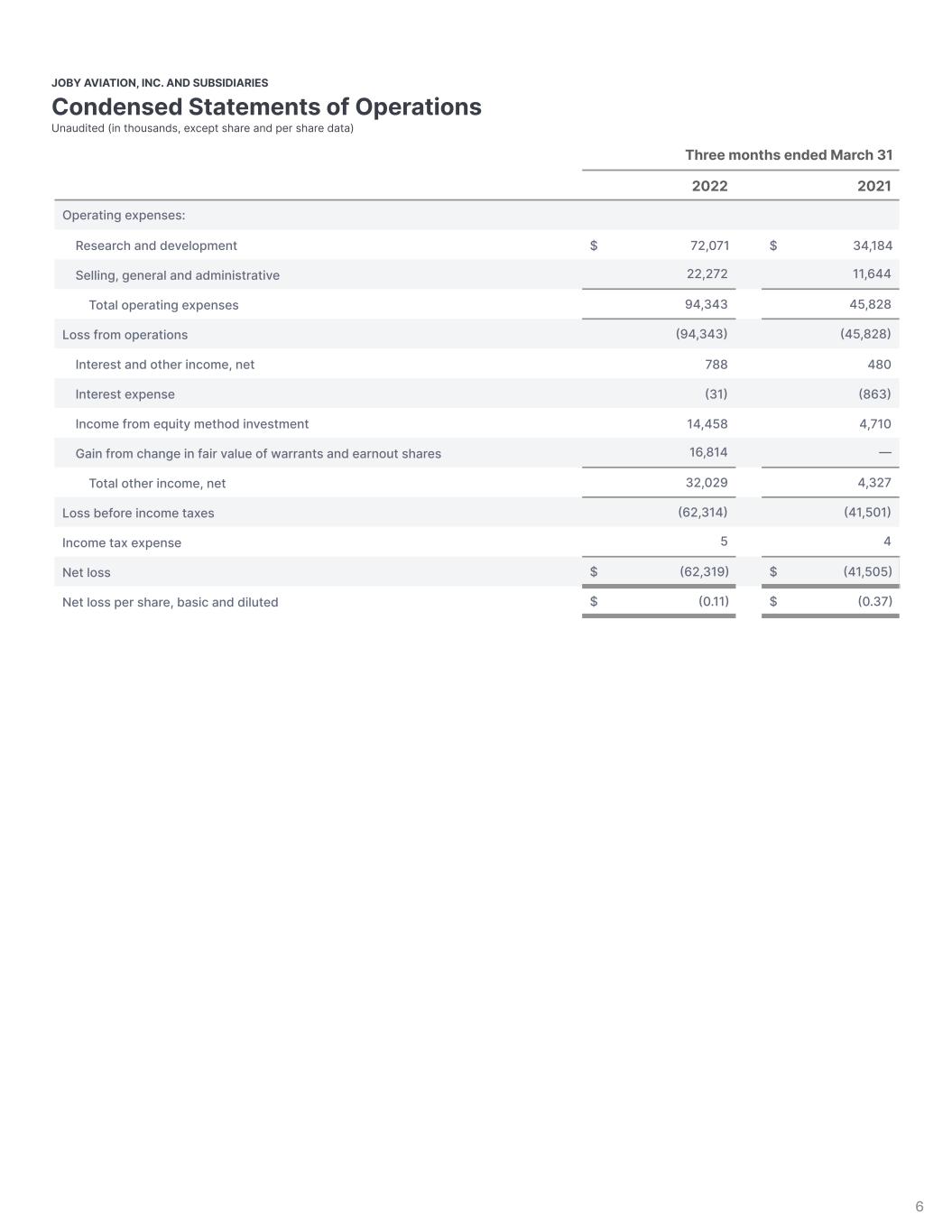
Three months ended March 31 2022 2021 Operating expenses: Research and development $ 72,071 $ 34,184 Selling, general and administrative 22,272 11,644 Total operating expenses 94,343 45,828 Loss from operations 94,343 45,828 Interest and other income, net 788 480 Interest expense 31 863 Income from equity method investment 14,458 4,710 Gain from change in fair value of warrants and earnout shares 16,814 — Total other income, net 32,029 4,327 Loss before income taxes 62,314 41,501 Income tax expense 5 4 Net loss $ 62,319 $ 41,505 Net loss per share, basic and diluted $ 0.11 $ 0.37 JOBY AVIATION, INC. AND SUBSIDIARIES Condensed Statements of Operations Unaudited (in thousands, except share and per share data) 6
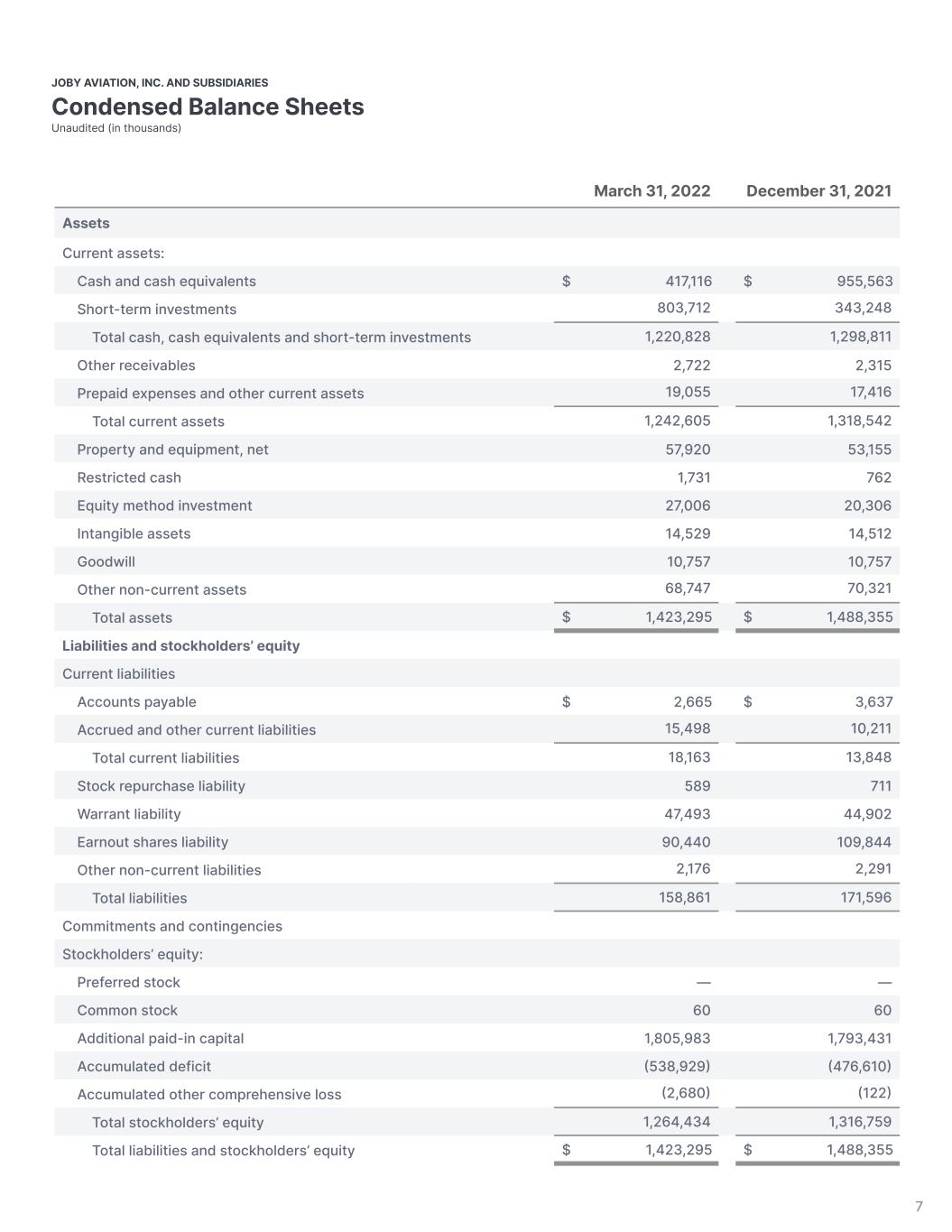
March 31, 2022 December 31, 2021 Assets Current assets: Cash and cash equivalents $ 417,116 $ 955,563 Short-term investments 803,712 343,248 Total cash, cash equivalents and short-term investments 1,220,828 1,298,811 Other receivables 2,722 2,315 Prepaid expenses and other current assets 19,055 17,416 Total current assets 1,242,605 1,318,542 Property and equipment, net 57,920 53,155 Restricted cash 1,731 762 Equity method investment 27,006 20,306 Intangible assets 14,529 14,512 Goodwill 10,757 10,757 Other non-current assets 68,747 70,321 Total assets $ 1,423,295 $ 1,488,355 Liabilities and stockholders’ equity Current liabilities Accounts payable $ 2,665 $ 3,637 Accrued and other current liabilities 15,498 10,211 Total current liabilities 18,163 13,848 Stock repurchase liability 589 711 Warrant liability 47,493 44,902 Earnout shares liability 90,440 109,844 Other non-current liabilities 2,176 2,291 Total liabilities 158,861 171,596 Commitments and contingencies Stockholders’ equity: Preferred stock — — Common stock 60 60 Additional paid-in capital 1,805,983 1,793,431 Accumulated deficit 538,929 476,610 Accumulated other comprehensive loss 2,680 122 Total stockholders’ equity 1,264,434 1,316,759 Total liabilities and stockholders’ equity $ 1,423,295 $ 1,488,355 JOBY AVIATION, INC. AND SUBSIDIARIES Condensed Balance Sheets Unaudited (in thousands) 7

Three months ended March 31 2022 2021 Cash flows from operating activities Net loss $ 62,319 $ 41,505 Reconciliation of net loss to net cash used in operating activities: Depreciation and amortization expense 5,212 3,333 Non-cash interest expense and amortization of debt costs — 825 Stock-based compensation expense 19,429 4,808 Other non-cash compensation expense — 1,741 Gain from change in the fair value of warrants and earnout shares 16,814 — Income from equity method investment 14,458 1,400 Net accretion and amortization of investments in marketable debt securities 774 1,622 Changes in operating assets and liabilities Other receivables and prepaid expenses and other current assets 418 1,995 Other non-current assets 9,332 32 Accounts payable and accrued and other liabilities 3,000 2,938 Net cash used in operating activities 61,426 29,665 Cash flows from investing activities Purchase of marketable securities 571,890 169,676 Proceeds from sales of marketable securities 34,506 26,825 Proceeds from maturities of marketable securities 73,550 142,054 Purchases of property and equipment 10,833 5,082 Acquisition, net of cash 1,465 — Net cash used in investing activities 476,132 5,879 Cash flows from financing activities Taxes paid related to net share settlement of equity awards 85 — Proceeds from capital lease obligation — 380 Proceeds from issuance of convertible notes — 74,972 Proceeds from the exercise of stock options and warrants issuance 427 309 Repayments of tenant improvement loan and capital lease obligation 262 160 Payments for deferred offering costs — 512 Net cash provided by financing activities 80 74,989 Net change in cash, cash equivalents and restricted cash 537,478 39,445 Cash, cash equivalents and restricted cash, at the beginning of the year 956,325 78,030 Cash, cash equivalents and restricted cash, at the end of the year $ 418,847 $ 117,475 Reconciliation of cash, cash equivalents and restricted cash to consolidated balance sheets Cash and cash equivalents $ 417,116 $ 116,782 Restricted cash 1,731 693 Cash, cash equivalents and restricted cash in consolidated balance sheets $ 418,847 $ 117,475 Non-cash investing and financing activities Upaid property and equipment purchases $ 426 $ 1,996 Uber acquisition in exchange for Series C redeemable convertible preferred stock — $ 77,619 Property and equipment purchased through capital leases $ 252 — JOBY AVIATION, INC. AND SUBSIDIARIES Condensed Statements of Cash Flows Unaudited (in thousands) 8
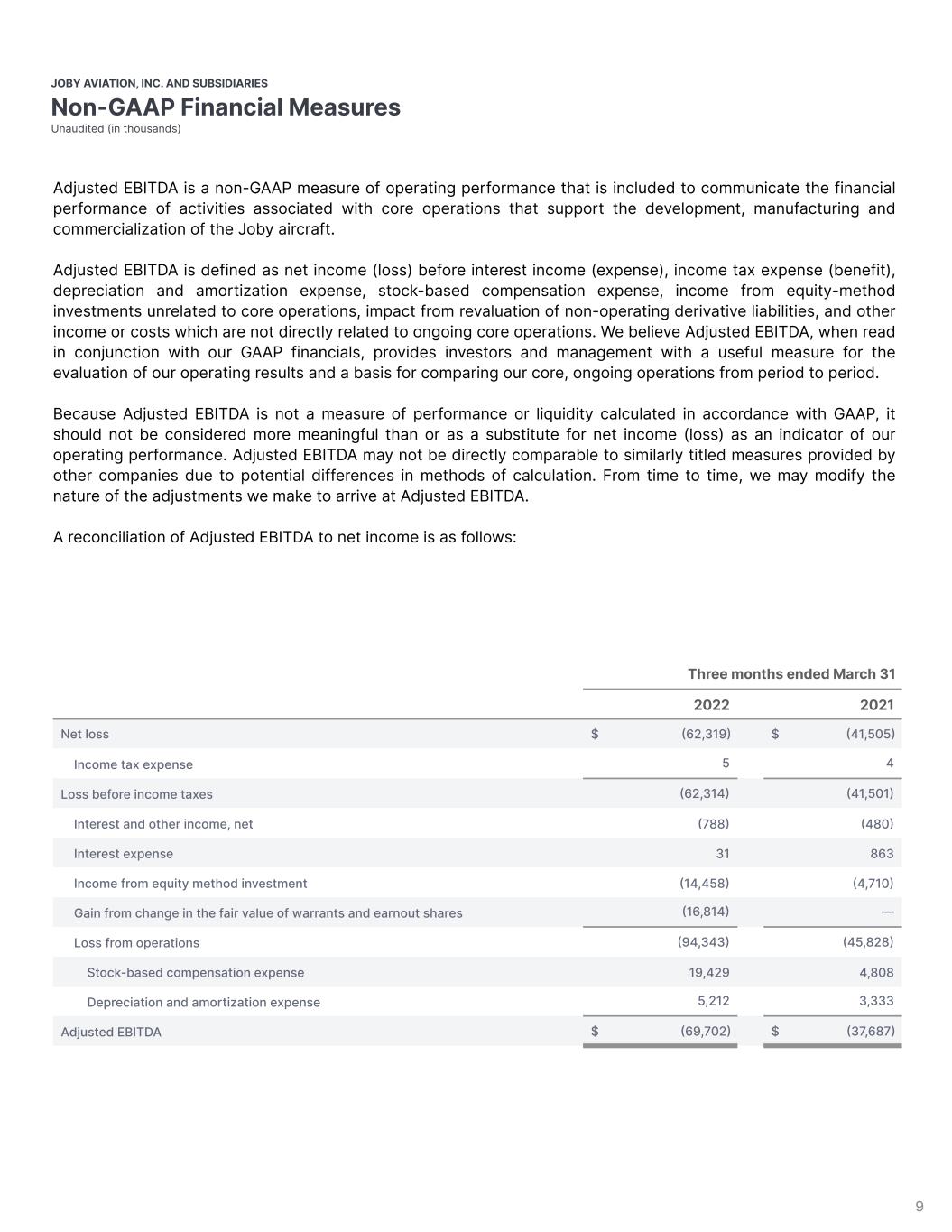
Three months ended March 31 2022 2021 Net loss $ 62,319 $ 41,505 Income tax expense 5 4 Loss before income taxes 62,314 41,501 Interest and other income, net 788 480 Interest expense 31 863 Income from equity method investment 14,458 4,710 Gain from change in the fair value of warrants and earnout shares 16,814 — Loss from operations 94,343 45,828 Stock-based compensation expense 19,429 4,808 Depreciation and amortization expense 5,212 3,333 Adjusted EBITDA $ 69,702 $ 37,687 JOBY AVIATION, INC. AND SUBSIDIARIES Non-GAAP Financial Measures Unaudited (in thousands) 9 Adjusted EBITDA is a non-GAAP measure of operating performance that is included to communicate the financial performance of activities associated with core operations that support the development, manufacturing and commercialization of the Joby aircraft. Adjusted EBITDA is defined as net income (loss) before interest income (expense), income tax expense (benefit), depreciation and amortization expense, stock-based compensation expense, income from equity-method investments unrelated to core operations, impact from revaluation of non-operating derivative liabilities, and other income or costs which are not directly related to ongoing core operations. We believe Adjusted EBITDA, when read in conjunction with our GAAP financials, provides investors and management with a useful measure for the evaluation of our operating results and a basis for comparing our core, ongoing operations from period to period. Because Adjusted EBITDA is not a measure of performance or liquidity calculated in accordance with GAAP, it should not be considered more meaningful than or as a substitute for net income (loss) as an indicator of our operating performance. Adjusted EBITDA may not be directly comparable to similarly titled measures provided by other companies due to potential differences in methods of calculation. From time to time, we may modify the nature of the adjustments we make to arrive at Adjusted EBITDA. A reconciliation of Adjusted EBITDA to net income is as follows:
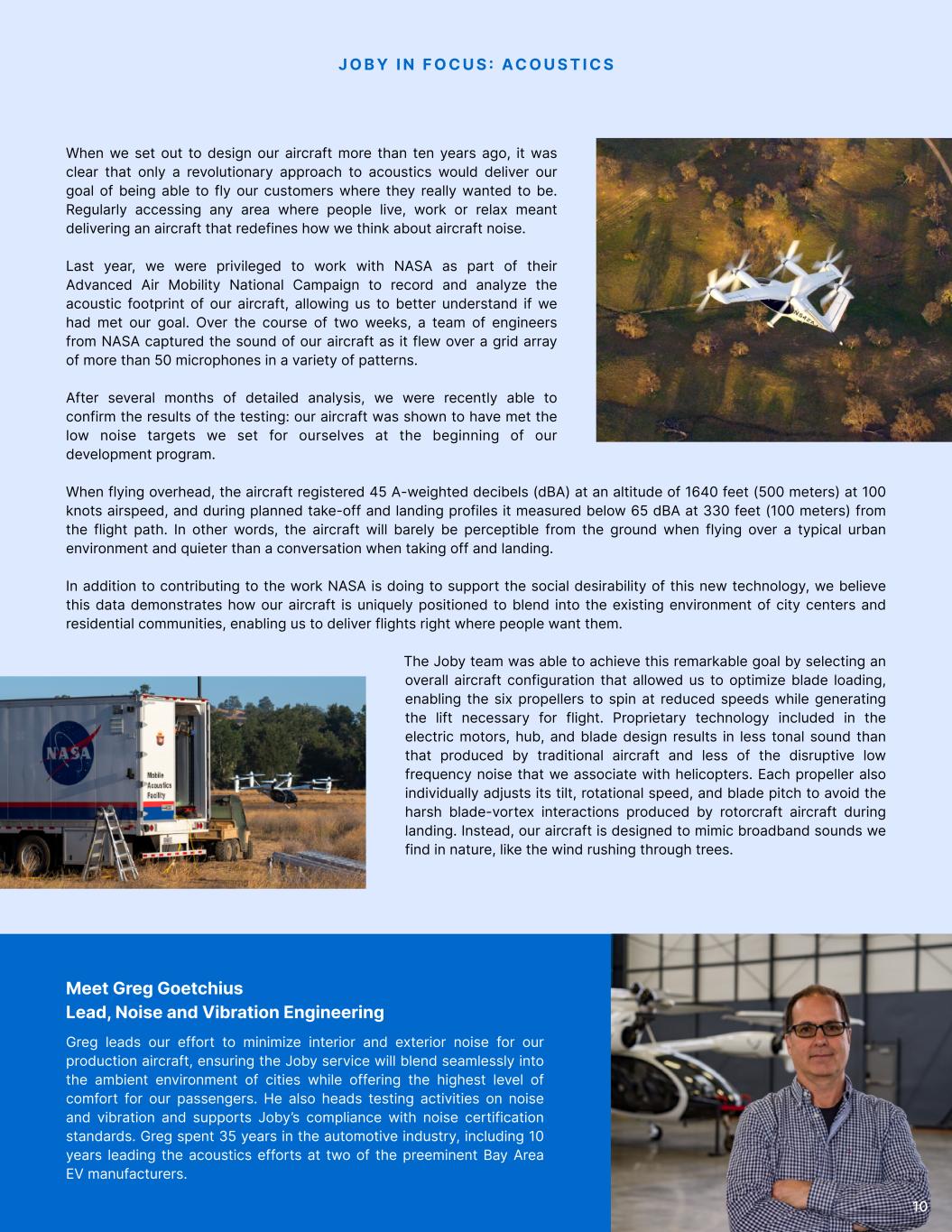
J O B Y I N F O C U S AC O U S T I C S When we set out to design our aircraft more than ten years ago, it was clear that only a revolutionary approach to acoustics would deliver our goal of being able to fly our customers where they really wanted to be. Regularly accessing any area where people live, work or relax meant delivering an aircraft that redefines how we think about aircraft noise. Last year, we were privileged to work with NASA as part of their Advanced Air Mobility National Campaign to record and analyze the acoustic footprint of our aircraft, allowing us to better understand if we had met our goal. Over the course of two weeks, a team of engineers from NASA captured the sound of our aircraft as it flew over a grid array of more than 50 microphones in a variety of patterns. After several months of detailed analysis, we were recently able to confirm the results of the testing: our aircraft was shown to have met the low noise targets we set for ourselves at the beginning of our development program. When flying overhead, the aircraft registered 45 A-weighted decibels (dBA) at an altitude of 1640 feet (500 meters) at 100 knots airspeed, and during planned take-off and landing profiles it measured below 65 dBA at 330 feet (100 meters) from the flight path. In other words, the aircraft will barely be perceptible from the ground when flying over a typical urban environment and quieter than a conversation when taking off and landing. In addition to contributing to the work NASA is doing to support the social desirability of this new technology, we believe this data demonstrates how our aircraft is uniquely positioned to blend into the existing environment of city centers and residential communities, enabling us to deliver flights right where people want them. The Joby team was able to achieve this remarkable goal by selecting an overall aircraft configuration that allowed us to optimize blade loading, enabling the six propellers to spin at reduced speeds while generating the lift necessary for flight. Proprietary technology included in the electric motors, hub, and blade design results in less tonal sound than that produced by traditional aircraft and less of the disruptive low frequency noise that we associate with helicopters. Each propeller also individually adjusts its tilt, rotational speed, and blade pitch to avoid the harsh blade-vortex interactions produced by rotorcraft aircraft during landing. Instead, our aircraft is designed to mimic broadband sounds we find in nature, like the wind rushing through trees. Meet Greg Goetchius Lead, Noise and Vibration Engineering Greg leads our effort to minimize interior and exterior noise for our production aircraft, ensuring the Joby service will blend seamlessly into the ambient environment of cities while offering the highest level of comfort for our passengers. He also heads testing activities on noise and vibration and supports Joby’s compliance with noise certification standards. Greg spent 35 years in the automotive industry, including 10 years leading the acoustics efforts at two of the preeminent Bay Area EV manufacturers. 10
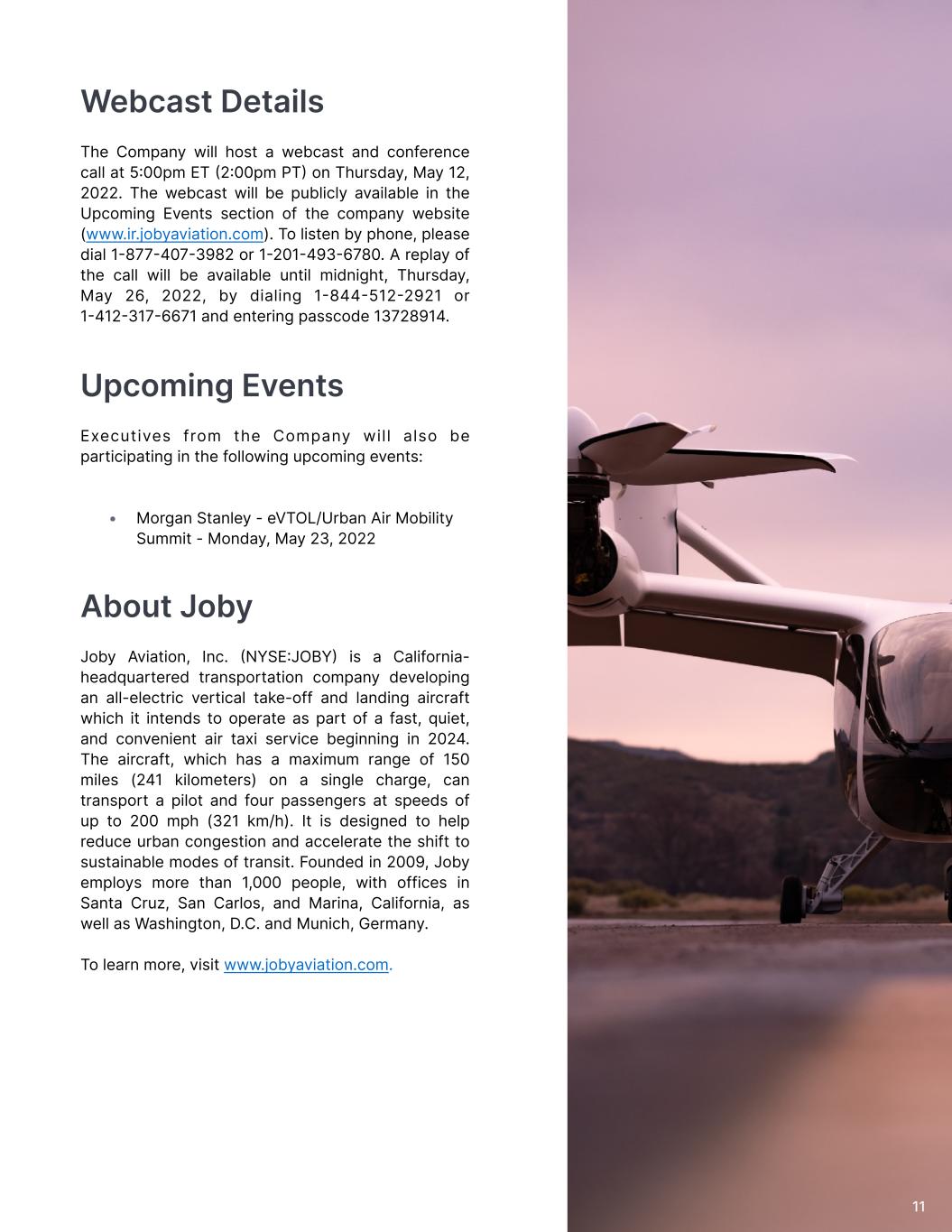
Webcast Details The Company will host a webcast and conference call at 500pm ET 200pm PT on Thursday, May 12, 2022. The webcast will be publicly available in the Upcoming Events section of the company website (www.ir.jobyaviation.com). To listen by phone, please dial 18774073982 or 12014936780. A replay of the call will be available until midnight, Thursday, May 26, 2022, by dialing 18445122921 or 14123176671 and entering passcode 13728914. Upcoming Events Executives from the Company will also be participating in the following upcoming events: • Morgan Stanley - eVTOL/Urban Air Mobility Summit - Monday, May 23, 2022 About Joby Joby Aviation, Inc. NYSEJOBY is a California- headquartered transportation company developing an all-electric vertical take-off and landing aircraft which it intends to operate as part of a fast, quiet, and convenient air taxi service beginning in 2024. The aircraft, which has a maximum range of 150 miles (241 kilometers) on a single charge, can transport a pilot and four passengers at speeds of up to 200 mph (321 km/h). It is designed to help reduce urban congestion and accelerate the shift to sustainable modes of transit. Founded in 2009, Joby employs more than 1,000 people, with offices in Santa Cruz, San Carlos, and Marina, California, as well as Washington, D.C. and Munich, Germany. To learn more, visit www.jobyaviation.com. 11
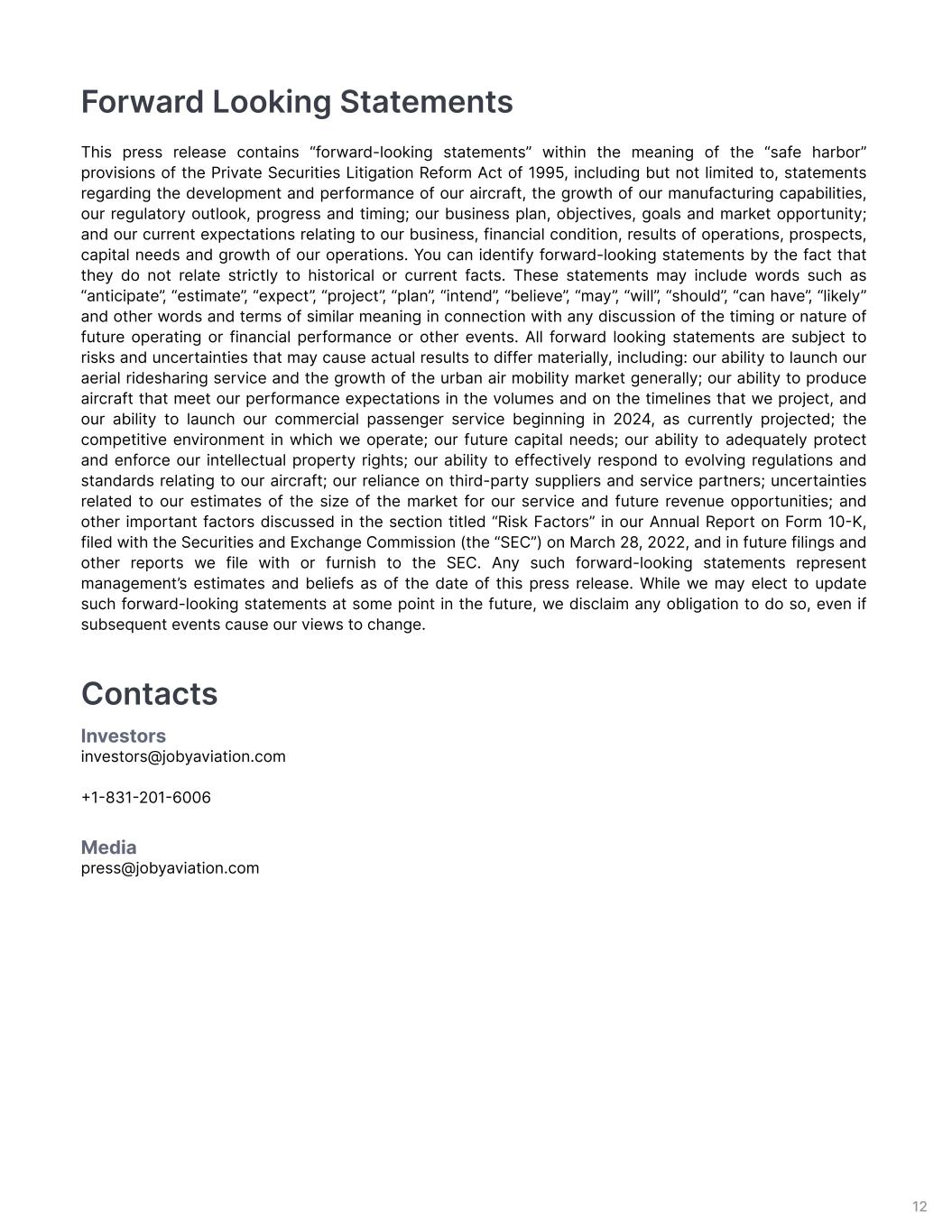
Forward Looking Statements This press release contains “forward-looking statements” within the meaning of the “safe harbor” provisions of the Private Securities Litigation Reform Act of 1995, including but not limited to, statements regarding the development and performance of our aircraft, the growth of our manufacturing capabilities, our regulatory outlook, progress and timing; our business plan, objectives, goals and market opportunity; and our current expectations relating to our business, financial condition, results of operations, prospects, capital needs and growth of our operations. You can identify forward-looking statements by the fact that they do not relate strictly to historical or current facts. These statements may include words such as “anticipate”, “estimate”, “expect”, “project”, “plan”, “intend”, “believe”, “may”, “will”, “should”, “can have”, “likely” and other words and terms of similar meaning in connection with any discussion of the timing or nature of future operating or financial performance or other events. All forward looking statements are subject to risks and uncertainties that may cause actual results to differ materially, including: our ability to launch our aerial ridesharing service and the growth of the urban air mobility market generally; our ability to produce aircraft that meet our performance expectations in the volumes and on the timelines that we project, and our ability to launch our commercial passenger service beginning in 2024, as currently projected; the competitive environment in which we operate; our future capital needs; our ability to adequately protect and enforce our intellectual property rights; our ability to effectively respond to evolving regulations and standards relating to our aircraft; our reliance on third-party suppliers and service partners; uncertainties related to our estimates of the size of the market for our service and future revenue opportunities; and other important factors discussed in the section titled “Risk Factors” in our Annual Report on Form 10K, filed with the Securities and Exchange Commission (the “SEC”) on March 28, 2022, and in future filings and other reports we file with or furnish to the SEC. Any such forward-looking statements represent management’s estimates and beliefs as of the date of this press release. While we may elect to update such forward-looking statements at some point in the future, we disclaim any obligation to do so, even if subsequent events cause our views to change. Contacts Investors investors@jobyaviation.com 18312016006 Media press@jobyaviation.com 12
